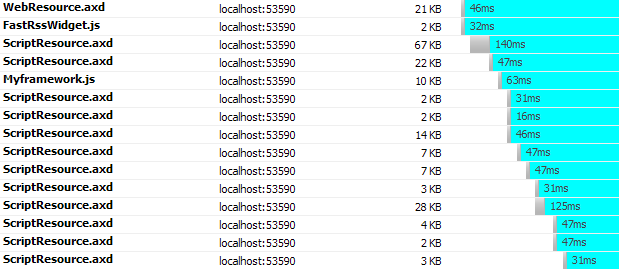UFrame combines
the goodness of UpdatePanel and IFRAME in a cross browser and
cross platform solution. It allows a DIV to behave like an
IFRAME loading
content from any page either static or dynamic. It can load pages
having both inline and external Javascript and CSS, just like an
IFRAME. But unlike IFRAME, it loads the content within the main
document and you can put any number of UFrame on your page without
slowing down the browser. It supports ASP.NET postback nicely and
you can have DataGrid or any other complex
ASP.NET control within a UFrame. UFrame works perfectly with
ASP.NET MVC making it an replacement for
UpdatePanel. Best
of all, UFrame is
implemented 100% in Javascript making it a cross platform solution.
As a result, you can use UFrame on ASP.NET, PHP,
JSP or any other platform.
<div class="UFrame" id="UFrame1" src="SomePage.aspx?ID=UFrame1" > <p>This should get replaced with content from Somepage.aspxp> div>
Response from SomePage.aspx is rendered
directly inside the UFrame. Here you see two
UFrame‘s are used
to load the same SomePage.aspx as if they are
loaded inside IFRAME. Another UFrame is used to load
AnotherPage.aspx
that shows photos from Flickr.
See it in action!
You can test UFrame from:
- http://labs.omaralzabir.com/UFrame2005
– Visual Studio 2005 version, .NET 2.0 implementation showing
regular ASP.NET 2.0 controls work as usual - http://labs.omaralzabir.com/UFrameMvc
– Visual Studio 2008 version shows ASP.NET MVC works fine making
UFrame an ultimate
replacement for UpdatePanel
What is UFrame?
UFrame can load
and host a page (ASP.NET, PHP or regular html) inside a DIV. Unlike
IFRAME which loads the content inside a browser frame that has no
relation with the main document, UFrame loads the content within
the same document. Thus all the Javascripts, CSS on the main
document flows through the loaded content. It’s just like
UpdatePanel with
IFRAME’s src
attribute.
The above UFrames are declared like
this:
<div id="UFrame1" src="SomePage.aspx" > <p>This should get replaced with content from Somepage.aspxp> div>
The features of UFrame are:
- You can build regular ASP.NET/PHP/JSP/HTML page and make them
behave as if they are fully AJAX enabled! Simple regular postback
will work as if it’s an UpdatePanel, or simple
hyperlinks will behave as if content is being loaded using
AJAX. - Load any URL inside a DIV. It can be a PHP, ASP.NET, JSP or
regular HTML page. - Just like IFRAME, you can set src property of DIVs and they
are converted to UFrames when UFrame library loads. - Unlike IFRAME, it loads the content within the main document.
So, main document’s CSS and Javascripts are available to the loaded
content. - It allows you to build parts of a page as multiple fully
independent pages. - Each page is built as standalone page. You can build, test and
debug each small page independently and put them together on the
main page using UFrames. - It loads and executes both inline and external scripts from
loaded page. You can also render different scripts during
UFrame
postback. - All external scripts are loaded before the body content is set.
And all inline scripts are executed when both external scripts and
body has been loaded. This way the inline scripts execute when the
body content is already available. - It loads both inline and external CSS.
- It handles duplicates nicely. It does not load the same
external Javascript or CSS twice.
Download the code
You can download latest version of UFrame along with the VS 2005
and VS 2008 (MVC) example projects from CodePlex:
Please go to the “Source Code” tab for the latest version. You
are invited to join the project and improve it or fix bugs.
Read the article about UFrame
I have published an article about UFrame at CodeProject:
http://www.codeproject.com/KB/aspnet/uframe.aspx
The article explains in details how the UFrame is built. Be
prepared for a big dose of Javascript code.
If you find UFrame or the article useful, please vote for me at
CodeProject.



